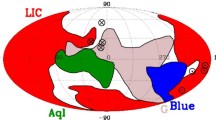Abstract
We analyze the angular structure of the 21-cm interstellar neutral hydrogen emission at six and seven declinations in the northern (published previously) and southern polar caps of the Galaxy (Galactic latitudes from −40° to −90°), respectively, with an extent of 90° in right ascension. The RATAN-600 radio telescope has a beam width averaged over these regions of 2.′0×30′. One-dimensional power spectra for the angular distribution of interstellar neutral hydrogen emission were computed in each 6.3-km s−1-wide spectral channel by using the standard Fast Fourier Transform (FFT) code and were smoothed over 1h in right ascension. The Galactic latitude dependence of the mean parameters for the sky distribution of H I line emission at high latitudes was found to correspond to the distribution of gas in the form of a flat layer only in the northern region, while in the southern cap, the gas distribution is much less regular. In addition, the mean H I radial velocities are negative everywhere (−3.7±3.0 km s−1 in the north and −6.0±2.4 km s−1 in the south). The power spectra of the angular fluctuations in the range of angular periods from 10′ to 6° appear as power laws. However, the spectral indices change greatly over the sky: from −3 to −1.2; on average, as the Galactic latitude increases and the H I column density decreases, the fluctuation spectrum of the interstellar gas emission becomes flatter. In the northern polar region, this behavior is much more pronounced, which probably stems from the fact that the gas column density in the south is generally a factor of 2 or 3 higher than that in the north. Therefore, the spectra are, on average, also steeper in the south, but the dependence on Galactic latitude is weaker. Using simulations, we show that the observed power-law spectrum of the H I emission distribution can be obtained in terms of not only a turbulent, but also a cloud model of interstellar gas if we use our previous spectra of the diameters and masses of H I clouds.
Similar content being viewed by others
References
Z. A. Alferova, I. V. Gosachinskii, S. R. Zhelenkov, and A. S. Morozov, Izv. SAO RAN 23, 89 (1986).
J. Ballesteros-Paredes, E. Vasquez-Semadeni, and J. Scalo, Astrophys. J. 515, 286 (1999).
J. Crovisier and J. M. Dickey, Astron. Astrophys. 122, 282 (1983).
J. M. Dickey, N. M. McClure-Griffiths, S. Stanimirivic, et al., Astrophys. J. 561, 264 (2001).
I. Fejes and P. R. Wesselius, Astron. Astrophys. 24, 1 (1973).
I. Goldman, Astrophys. J. 541, 701 (2000).
I. V. Gosachinskii and V. V. Morozova, Astron. Astrophys. Trans. 11, 215 (1996).
I. V. Gosachinskii and V. V. Morozova, Astron. Zh. 76, 883 (1999) [Astron. Rep. 43, 777 (1999)].
I. V. Gosachinskii, G. N. Il'in, A. S. Morozov, and V. A. Prozorov, Pis'ma Astron. Zh. 25, 820 (1999) [Astron. Lett. 25, 712 (1999)].
D. A. Green, Mon. Not. R. Astron. Soc. 262, 327 (1993).
D. Hartmann, P. M. W. Kalberla, W. B. Burton, and U. Mebold, Astron. Astrophys., Suppl. Ser. 119, 115 (1996).
C. Heiles, S. Kulkarni, and A. A. Stark, Astrophys. J. Lett. 247, L73 (1981).
G. N. Il'in, V. A. Prozorov, and A. M. Pilipenko, in Proceedings of the XX VII Radioastronomy Conference: Problems of Modern Radioastronomy (IPA RAN, St. Petersburg, 1997), p. 128.
S. A. Kaplan and S. B. Pikelner, Physics of the Interstellar Medium (Nauka, Moscow, 1979) [in Russian].
A. Lazarian, Astron. Astrophys. 293, 507 (1995).
A. Lazarian and D. Pogosyan, Astrophys. J. 537, 720 (2000).
R. X. McGee and L. M. Newton, Publ. Astron. Soc. Australia 6, 358 (1986).
A. P. Venger, I. V. Gosachinskii, V. G. Grachev, and N. F. Ryzhkov, Izv. SAO RAN 14, 118 (1981).
A. P. Venger, V. G. Grachev, T. M. Egorova, et al., Soobshch. SAO RAN, No. 35, 5 (1982).
A. P. Venger, I. V. Gosachinskii, N. A. Esepkina, et al., in Proceedings of the XXVII Radioastronomy Conference: Problems of Modern Radioastronomy (IPA RAN, St. Petersburg, 1997), p. 130.
Author information
Authors and Affiliations
Additional information
__________
Translated from Pis'ma v Astronomicheski\(\overset{\lower0.5em\hbox{$\smash{\scriptscriptstyle\smile}$}}{l} \) Zhurnal, Vol. 30, No. 4, 2004, pp. 268–276.
Original Russian Text Copyright © 2004 by Gosachinskii, Il'in, Prozorov.
Rights and permissions
About this article
Cite this article
Gosachinskii, I.V., Il'in, G.N. & Prozorov, V.A. The structure of Galactic gas at high latitudes: The southern polar cap. Astron. Lett. 30, 232–239 (2004). https://doi.org/10.1134/1.1695083
Received:
Issue Date:
DOI: https://doi.org/10.1134/1.1695083



